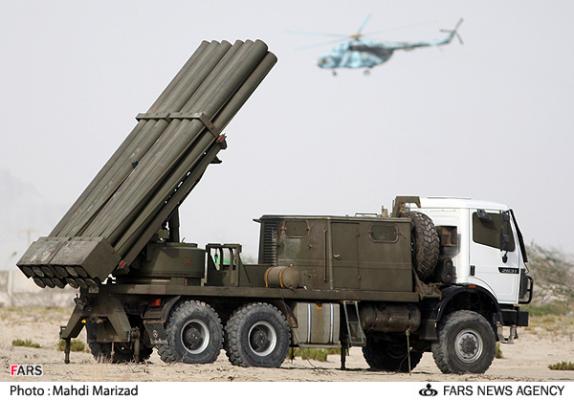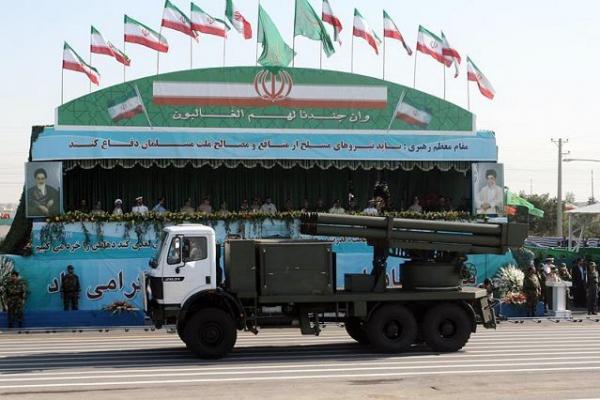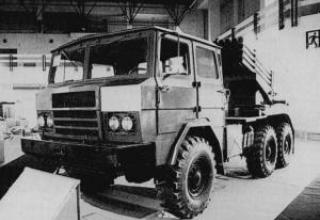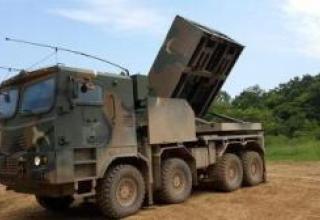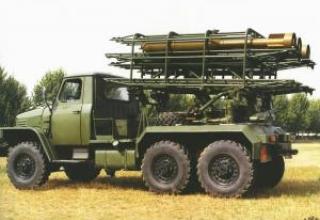The Fadjr-3 combat vehicle is designed to perform tasks to suppress important enemy targets: command and communication centers, supply centers, firing positions of artillery and missiles, areas of concentration of troops and military equipment, political and economic facilities, airports, factories, etc.
The system was developed by specialists from Shahid Bagheri Industries, Iran's aerospace industry organization, with technical assistance from DPRK specialists. Some sources argue that the Fadjr-3 was based on the North Korean M1985 (M-1985) combat vehicle.
Mass production of the system started presumably in 1990, although according to other information the Fadjr-3 was tested only six years later.
The first model of the Fajr-3 was demonstrated at a military parade in Tehran in 1996, at the same time reports appeared that the system was in service with Hezbollah units operating in southern Lebanon.
By mid-1996, there were reports that Iran had developed its own MLRS (240 mm calibre, range 40 km), known as the FADJR-3. The new system was developed and produced by specialists from the Missile Technology Department of the Iranian Defense Industry Association (DIO).
Currently the Fajr-3 is in service with the artillery units of the Iranian Army. Source /3/ describes the system as Fadjr-6.
Composition:
Fighting vehicle (BM) Fadjr-3 has a classic layout. In front of the BM is a sealed cabin, which houses the mechanic-driver and commander of the calculation. Radio communications and firing control devices are also mounted here. To protect from gunpowder gases of projectiles at startup, the windshield of the cabin is closed with special panels. In the middle part there is an additional cabin for the numbers of calculation of the BM (3-4 people), and at the rear of the chassis there is an artillery unit.
For the first time BM Fadjr-3 was seen on the modified chassis of the Japanese truck Isuzu 6×6, and later was used modified chassis of the truck Megses-Benz 2624 6×6. As of April 2011, a modified chassis of Mercedes-Benz 2631 truck is used for the new generation of combat vehicles, which became standard.
The artillery unit of the combat vehicle consists of two semi-packages of six tubular tracks, each of which has two rows of three tracks in each. The artillery unit is equipped with manual elevation angle and azimuth actuators. Four jacks are used to stabilise the PM during firing.
Uncontrollable 240 mm caliber rockets with stabilizer blades are used for firing, which are opened after launch. Head units are of the following types: high-explosive, fragmentation, incendiary, smoke-smoking, chemical, and cassette type, when equipped with combat units.
The projectiles are stored and transported in cages of three pieces with a total weight of 1650 kg.
Shots are fired in single shots or in volley. The interval between the discharges of projectiles from the rails is 4-8s. The time of full salvo is 48-96s. After firing, the fighting vehicle moves to the technical position, where it is recharged by crane.
The fire control system is similar to the BM Fadjr-5.
Characteristics:
| Fighting vehicle Fadjr-3 | |
| Dimensions in camping position,mm - length - width - altitude |
10450 2540 (2500) 3340 |
| Weight of combat vehicle, kg | 15000 |
| Maximum travel speed, km/h | 60 |
| Number of tubular rails, pcs. | 12 |
| Angle of elevation, ° - minimum - maximum |
0 +57 |
| Angle of horizontal firing, ° - to the right of the chassis axle - to the left of the driving axle |
100 90 |
| NURS Specifications | |
| Caliber, mm | 240 |
| The length of the projectile, mm | 5200 |
| Weight, kg: - shell - shrapnel header - header charge |
407 90 45 |
| Maximum projectile range, m | 43000 |
| Maximum trajectory height when firing at maximum range, m | 17000 |
| Operating temperature range, ºC | between -40 and 50 |
Testing:
Having unique flight and tactical characteristics, MiG-25P for a long time was operated only as part of the Soviet air defense fighter aircraft. In the early 1980s, its delivery abroad began, and soon its baptism of fire took place. Even before the beginning of the large-scale Lebanese conflict, in spring 1981, the Syrians announced the destruction of the F-15.
According to the Iraqi Air Force Command, from December 1982 to October 1986, during the Iran-Iraq war, the Iraqi MiG-25 shot down an Iranian F-5E fighter, an EU-130E counter-electronic aircraft, and three Phantoms, including one in a reconnaissance version.
During Operation Desert Storm, January 17, 1991, Iraqi MiG-25 managed to shoot down an American F/A-18, and in 2002 - an unmanned reconnaissance drone Predeitor.
Sources:
- Christopher F Foss. Iran reveals more details of Fadjr rocket systems. // Jane’s defence weekly. – 26 April 2000. – Vol. 33. – № 17. – P. 16.
- FADJR-3. AEROSPACE INDUSTRIES ORGANIZATION.
- Jane’s Ammunition Handbook 1997-98. – P. 549.
- Jane’s Armour and Artillery 2000-2001. – P. 783.
- Технические характеристики РСЗО зарубежных стран. Справочные данные. // Зарубежное военное обозрение. – № 10. – 2000. – С. 23.
- http://thearkenstone.blogspot.com/2011/03/iranian-military-capability-2011-open.html
- http://war.163.com/06/1107/13/2VB2MU9800011233.htm/
- ПРОГРАММА ИРАНА ПО ЗАКУПКЕ ВООРУЖЕНИЙ И СТАБИЛЬНОСТЬ В РЕГИОНЕ ПЕРСИДСКОГО ЗАЛИВА. – ВОЕННО-ТЕХНИЧЕСКОЕ СОТРУДНИЧЕСТВО. Обзор российской и зарубежной прессы. – 1997. – № 12 (38). – 17 - 23 марта 1997 г. – С. 75,76.
- Теунов Н. Реактивные системы залпового огня «Фаджр» сухопутных войск Ирана. Зарубежное Военное Обозрение, №11, 2011 г.
